|
Hebrew Noun Pluralization Rules
As mentioned in section 4.1, Hebrew adds endings to the basic noun form (shoresh or stem) to express gender and number. These endings can be summarized as follows:

When endings are added to Hebrew nouns, vowel changes, accent changes, and changes in spelling may occur. This section lists some of the more common changes.
Case 1: No Vowel Change
This class of noun does not produce any sort of change apart from the addition of the plural endings. Often these nouns are monosyllabic or have a reduced first syllable.
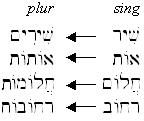
In the examples above, there is no change to the vowels when the endings are added to the singular form of the word. For example, shir (song) uses a Chireq and the Chireq is retained after the ending is added to the word. (As you will see, this is often not the case.)
Case 2: Propretonic Reduction
Many nouns that have a Qamets or Tsere vowel as their first syllable undergo "propretonic reduction" when the plural endings are added to the word:
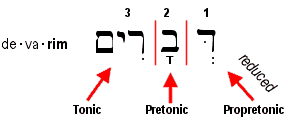
In the example above, when the word davar has been pluralized, the first syllable (Qamets) is reduced to Sheva when the plural ending is added to the word.
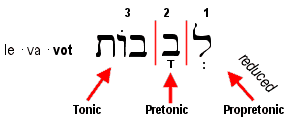
In the example above, when the word levav (heart) has been pluralized, the first syllable (Tsere) is reduced to Sheva when the plural ending is added to the word.
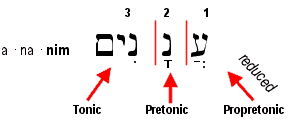
In the example above, when the word anan (cloud) has been pluralized, the first syllable (Qamets) is reduced to Chateph Patach when the plural ending is added to the word (remember that a guttural letter cannot take a vocal sheva).
Case 3: Segolate Nouns
For our purposes, Segolate nouns may be defined as two syllable nouns that are accented on the first syllable (often both syllables contain the Segol vowel, though not always). Basically, segolate nouns form their plural by undergoing "propretonic reduction" and lengthening the second syllable when the plural endings are added to the word.
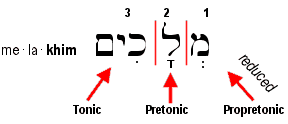
The word melekh (king) is a segolate noun (Mem-Segol-Lamed-Segol-Khaf). When it is pluralized, however, the first vowel is reduced to sheva and the second vowel lengthens to Qamets. This same pattern occurs for nefesh (soul), sefer (book), and zera (seed), among many others.
Case 4: Geminate Nouns
A "geminate" noun has a hidden twin letter that does not appear in the singular form. The hidden letter reappears in the plural form with a strong dagesh mark:

In the diagram above, the (X) character refers to the hidden letter that has been dropped in the singular form but reappears in the plural, after the endings are added.

In the first example, the word am (people, nation) reveals the hidden third letter of the root when the plural form is shown. In the second example, the word chets (tree) likewise reveals its hidden third letter in the plural.
Case 5: Irregular Plurals
As you studied in section 4.4, some Hebrew nouns do not follow the standard pattern when forming their plural. These cases of noun are sometimes called "irregular," since they are not the usual form you might expect (English also has irregular plural forms, for example, the plural of foot is feet, or the plural of child is children). In the case of irregular Hebrew plurals, you simply have to memorize the forms.
- Most city names are feminine (even if formed with a masculine ending) (Yerushalayim)
- Most country names are feminine (mitsrayim - Egypt)
- Some words are always "dual" - (shamayim, mayim)
- Some words evidence "defective spelling" of their vowels (full vowels with dropped Vav or Yod)
- Some plural forms use infix letters (anashim - people)
- Some plural forms use the opposite ending than expected (avot - fathers,
irim - cities)
See section 4.4 for specific examples.
Section Exercises
- Memorize the basic rules for pluralization and provide one or two examples
- Syllabify and identify the tonic, pretonic, and propretonic syllables of some plural nouns you know.
- Understand how to pronounce segolate nouns
<< Return
|


